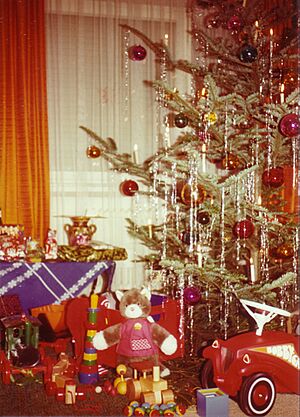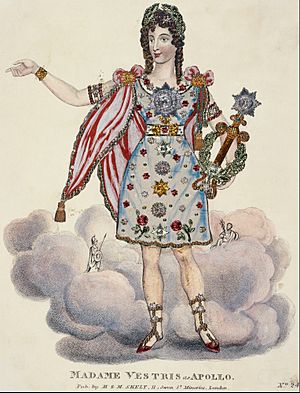Tinsel facts for kids
Tinsel is a shiny decoration that looks like ice. It's made of thin, sparkling strips attached to a thread. When these strips are long and narrow, but not on a thread, they are called "lametta". Lametta is meant to look like icicles.
Tinsel was first used as a metallic decoration for Christmas. Today, most tinsel is made from plastic. It's very popular for decorating Christmas trees. You can also hang it from ceilings or wrap it around statues and lampposts. Tinsel was invented in Nuremberg, Germany, in 1610. It was originally made from shredded silver. The word "tinsel" comes from an old French word, estincele, which means "sparkle".
The History of Tinsel
In the 1500s, the word "tinsel" was used for light fabrics that looked metallic. These fabrics were made with silk and gold or silver threads. Important people like Elizabeth of York and Margaret Tudor wore clothes made from "tinsel satin." These fabrics were less expensive than Cloth of gold.
Modern tinsel was created in Nuremberg around 1610. It was first made from thin strands of silver. But silver can tarnish (turn dark) quickly. So, people started using other shiny metals instead.
Before the 1800s, tinsel was used to decorate sculptures. It wasn't mainly for Christmas trees yet. When it started being used on Christmas trees, it helped make the candles on the tree look even brighter. Tinsel was also used to represent the starry sky above a Nativity scene.
By the early 1900s, new ways of making things allowed for cheap tinsel made from aluminum. Until World War I, France was the main producer of tinsel. Production slowed down during the war because copper was needed for other things.
In the 1950s, tinsel was very popular. It was often used more than Christmas lights. Tinsel was also safer than lights for the popular aluminum Christmas trees, which could catch fire easily.
For many years in the 1900s, Lead foil was used to make tinsel. Lead tinsel didn't tarnish like silver, so it stayed shiny. However, people stopped using lead tinsel after the 1960s. This was because there were worries that it could cause lead poisoning in children. In the United States, the Food and Drug Administration (FDA) asked companies to stop making or importing lead tinsel after January 1, 1972.
Today, most tinsel is made from polyvinyl chloride (PVC) plastic film. This film is coated to make it look metallic. Sometimes, coated mylar film is also used. These plastic types of tinsel don't hang quite as heavily or smoothly as the older tinsel made from metals like silver or lead.
Tinsel in Sayings and Culture
In Germany, people sometimes call a row of military medals Lametta. This is like saying someone is dressed up with lots of shiny decorations. The famous German comedian Loriot once made a film where a grandfather says, "There used to be more tinsel!" This phrase became well-known. It means that things change over time, and sometimes people miss the way things used to be.
Other Uses for Tinsel
Tinsel prints are special pictures where tinsel is added after printing. This makes them look more decorative. One type is a rare German religious woodcut from the 1400s. Another type is English from the 1800s, often showing actors in their stage roles.
Tinsel has many traditional uses in India. It's used to decorate images, make garlands for weddings and other ceremonies, and create fancy decorations for horses and elephants. Tinsel is also a popular material used in fly tying, which is a way to make artificial fishing lures.
See also
 In Spanish: Espumillón para niños
In Spanish: Espumillón para niños





